This is an archive of information released in the past.
Disclaimer: It may contain broken links or outdated information. Some parts may not function in current web browsers.
*Visit https://humans-in-space.jaxa.jp/en/ for the latest information.

Experiment
- News
- Kibo Utilization Strategy
- Kibo Utilization Plan
- List of JAXA's Utilization Themes
- Experiment Facilities
- Space Environment Utilization
- Archive
Microgravity Science
Microgravity Characteristics
There are four factors that influence the behavior of liquids and gas in a microgravity environment: 1)"Absence of buoyancy and sedimentation", 2)"Absence of convection", 3)"Absence of hydrostatic pressure" and 4)"containerless float". These phenomena nullify what generally are considered as natural phenomena on Earth. In addition, phenomena, which are hidden by the gravitational effects, would show themselves quite clearly in the microgravity environment. If these gravitational forces that pulls everything downwards on Earth are negated in microgravity, then these phenomena can be observed more clearly in space.
By utilizing the microgravity conditions, space experiments have been conducted for both technological aspects, such as the development of new materials and discovering solutions to manufacturing problems, and scientific aspects, such as, discovering unknown physical and chemical phenomena.
These space experiments have achieved some positive results, such as proving theories and revealing previously unexplained phenomena. Currently, efforts to apply those results are being made.
Absence of buoyancy and sedimentation
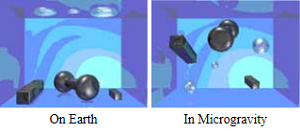
On Earth, heavy substances will sink while lighter ones will float. In microgravity, substance of different relative density, such as water and oil, will disperse evenly, thus leading to the potential of manufacturing more highly advanced materials.
Absence of convection
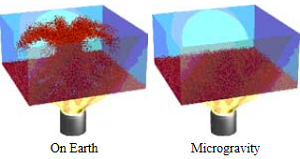
On Earth, heated liquids and gas have lighter relative density, thus causing convection. In a microgravity environment, there's no convection due to different relative densities. Therefore, it is expected that the manufacturing of materials without any affects from convection may be possible, thus resulting in the manufacturing of higher quality materials that are not possible to produce on Earth.
Absence of hydrostatic pressure
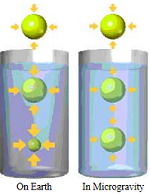
On Earth, hydrostatic pressure increases in the deeper depths of the liquid. This is due to the weight of liquid itself. Almost no hydrostatic pressure exists in microgravity. This is quite effective when working with soft materials.
Containerless float

Liquids cannot be contained without the use of containers on Earth. In microgravity however, liquids can float in the air without a container. This makes it possible to determine the liquid's characteristics, to understand chemical reactions, to develop new materials with new functionality in a containerless environment, and develop new materials free from any contamination from containers.
Space Experiments Utilizing Microgravity
Major experiments in space that utilized microgravity started in 1970s. These experiments have over thirty years of history, including experiments conducted on the Space Shuttles while orbiting the Earth. Many experiments using aircrafts, small rockets and free-flyers have been performed as well. Short duration microgravity experiments that utilized free-fall experiment facilities have been on going since the 1950s.
When analyzing the history of experiments conducted in space, the Skylab Project, which started in 1973 and a project that Japan participated in, demonstrated the merits of space experiments and has provided a boost in space environment utilization, ever since. The crystal growth experiment for semiconductors resulted in higher quality and larger sized crystals that would have been impossible to obtain on Earth. The electrical characteristics also exhibited better uniformity as well. Gold and germanium alloys produced on Earth, exhibit a very rough dispersal and separation of the metals. However, in space, the produced alloys exhibited a very uniformed quality. After further analysis, it was determined that this alloy was a compound that could not be formed under gravity conditions. This led to a significant amount of attention and to expectations of further metal processing possibilities under microgravity conditions. This period of time was the groundbreaking years for conducting experiments in space. Also, the "Cat's Whisker" experiment proposed by Japan was successfully conducted at the Skylab. The experiment's goal was to disperse fine crystals of silicon carbide in molten silver. Conducting the first on-orbit Japanese space experiment drew a significant amount of interest.
Between the 1980s and 1990s, periodic experiment opportunities were provided by the Space Shuttle. Many experiments from a variety of fields were performed and experiments in space entered its growth stage. Japan started conducting major experiments in Earth's orbit in 1992, beginning with the First International Microgravity Laboratory (IML-1) and the First Material Processing Test (FMPT). In the Material Science field, 22 experiments have been conducted. Japan's space experiments have made remarkable progress. Active participation in the Second International Microgravity Laboratory (IML-2) and the First Microgravity Science Laboratory (MSL-1) followed. Japan utilized the TR-IA, a Japanese developed small rocket, to perform experiments that added to Japan's growing experience in space. Through these experiences, Japan rose to a world leadership position in such fields as, Material Science utilizing electrostatic levitation furnace, diffusivity measurements using shear cell methods, and simultaneous ad-hoc observation technology of thermal field and density field by dual wavelength interference microscope.
Experiments conducted in Skylab, the Space Shuttle and using small rockets have produced many results that in turn, have become guides for conducting future space experiments. We are about to shift from a time where the purpose is on conducting experiments using the long term experiment facility at the International Space Station (ISS) to where the focus is on performing experiments that fully utilizes microgravity, thus leading to the development of space experiments that will produce significant and invaluable results.
Material Science and Material Engineering
Material Science and Material Engineering are research fields, which focus on understanding the relationships between the microstructure and physical aspects of materials and their effects on the material's manufacturing process. The research activities ultimately aim to establish the material's manufacturing processes that have particular outstanding characteristics by design. Japan is the world's leader in the field of advanced material manufacturing, such as in electronic and optical materials. In addition, Japan has achieved significant results in the field of Microgravity Science, including single crystal growth of semiconductors and the solidification experiments on metal alloy.
In the technology field that's associated with space experiments, Japan is at the cutting edge through the establishment of electrostatic containerless technology, diffusivity measurement by using shear cell methods, and simultaneous ad-hoc observation technology in the thermal and density fields by using dual wavelength interference microscopes.

Simplified illustration of the shear cell method
Accuracy is enhanced in using this method since it allows dispersion only when the temperature is stable, thus removing any influence of heating and cooling.
Fluid Physics
The goal of Fluid Physics is to understand the behavior of fluids, to contribute to semiconductor manufacturing, and the development and manufacturing of food and medical products. Research in such areas as, Marangoni convection, two-phase flow and boiling phenomenon has been the main focus in Fluid Physics research under microgravity conditions. Significant and numerous experiments in relations to Marangoni convection are being conducted.
Marangoni convection is the convection caused by the heterogeneity of the surface tension on the liquid's free surface. An Italian physicist theoretically predicted this in the 19th century, but it was in a space experiment that this phenomenon was experimentally demonstrated.
Microgravity effectively influences substances in the liquid or gaseous states. Therefore, one of the primary goals of microgravity experiments is in the understanding and analysis of fluid phenomena.
Japan's researches on Marangoni convection is characterized by two aspects: 1) pure hydrodynamic studies using material models and 2) studies aiming at enhancing the quality of electric devices by using currently available materials.
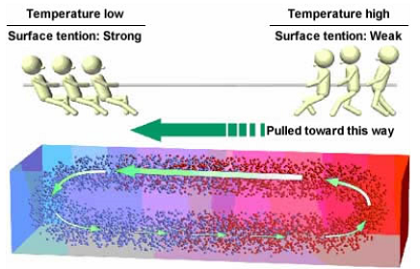
Principal of Marangoni convection generation
In Marangoni convection, the surface is pulled towards the surface with a lower temperature when differences exist in the interface temperature between the gas and liquid, thus causing convection. This convection is the Marangoni convection.
Combustion Science
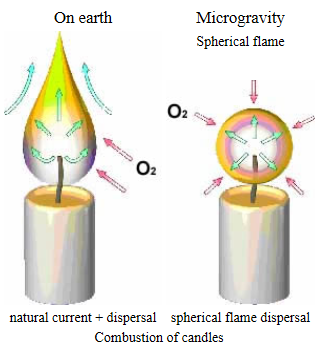
Combustion is the phenomenon in which fuel interacts with oxygen and emits heat. Human beings obtain 85% of their energy needs through combustion. Therefore, energy exchange through combustion is closely related to our daily life and industrial activities, as well as, to our concerns with environmental related issues. During combustion, the combustion stages, such as ignition, inflammation and extinction, takes place extremely fast. Therefore, analyzing each of these stages separately will lead to a better understanding of the combustion interactions, which in turn will lead to improvements in combustion equipments and alleviate environmental concerns.
Microgravity environments have played a significant role in understanding the dynamics of combustion. In a gravitational environment, the rising air current occurs around the flame. This is due to significant density changes caused by combustion, which does not occur in a microgravity environment. Thus, combustion science is potentially one of most significant research fields under microgravity conditions.
Japan was one of the first countries to begin combustion research in microgravity conditions. Ever since Professor Kumagai began his research in 1957, Japanese researchers have been aggressively active in this field, especially by utilizing free-fall towers and aircrafts (parabolic flights). The research focus is on understanding the mechanisms of atomizing combustion, focusing on the fundamental processes and systems in comparison with related theories. The conducted experiments are far ranging including, fuel droplet array and matrix, and experiments on fuel droplet groups that are close to the actual atomizing.
Summary of Experiments in Microgravity
![]() Number of Japanese space experiments utilizing the Space Shuttle, free-flyers and small rockets (Microgravity Science)
Number of Japanese space experiments utilizing the Space Shuttle, free-flyers and small rockets (Microgravity Science)

IML-1 : First International Microgravity Laboratory
FMPT : First Material Processing Test
IML-2 : Second International Microgravity Laboratory
SFU : Space Flyer Unit
MSL-1 : First Microgravity Science Laboratory
TR-IA : Test Rocket for Space Experiment
![]() Number of publications on space experiments and number of patents granted
Number of publications on space experiments and number of patents granted
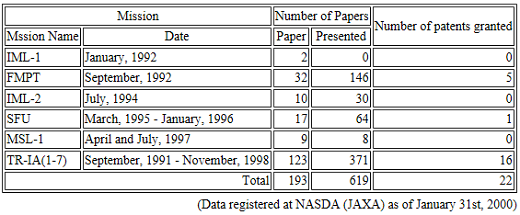
| Copyright 2007 Japan Aerospace Exploration Agency | Site Policy |